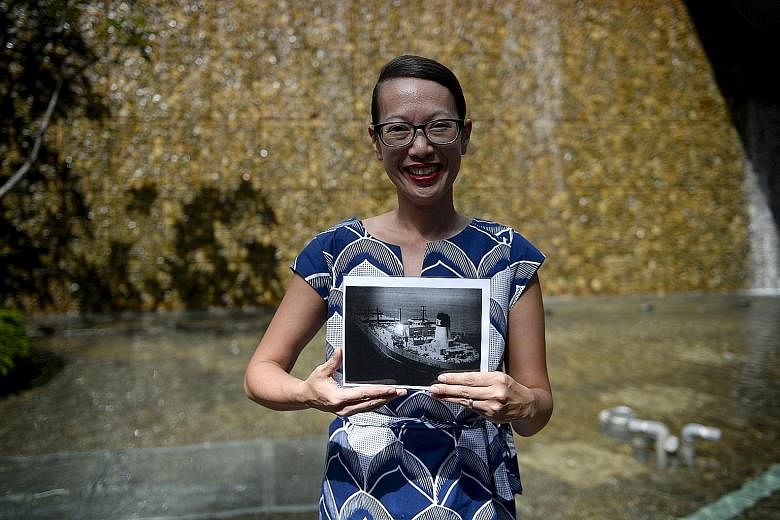When she was barely four years old, Australian-Vietnamese social entrepreneur Yen Siow was one of the hundreds of thousands of refugees who fled the country in flimsy, overcrowded boats across the South China Sea following the fall of South Vietnam to the communists in 1975.
Packed in a fishing boat meant for 10 people but filled with 82 refugees desperate for shelter in any neighbouring country, she and 12 members of her immediate and extended family spent five days adrift at sea in October 1980 - with no land in sight, and buffeted by severe storms.
Times were desperate. They were running out of food and water, and the engine of the boat stalled repeatedly. Many ships passed by, but did not stop to help, said Ms Siow, 39.
"Why would they want to pick up boat people? We would be a burden to any ship, and were basically waiting for death to come knocking," said the mother of three boys, aged between five and 10, who is married to a Singaporean working in management consulting.
But on Oct 20, Norwegian oil tanker Berge Tasta did just that. It passed by the rickety boat before turning back and welcoming them on board, eventually taking them to Singapore where most were given shelter at the Hawkins Road Refugee Camp in Sembawang.
The camp, which was run by the United Nations High Commissioner for Refugees (UNHCR) from 1978 to 1996, was the first and only refugee camp here.
Two weeks ago, Ms Siow decided to start tracking down her Norwegian rescuers so that she could express her gratitude to them for saving her life.
Armed with a picture of the oil tanker that had been given to her cousin by a member of the ship's crew, she made several posts on Facebook groups with ties to the Norwegian community here.
She had merely asked for help to translate an e-mail into Norwegian, but received spontaneous offers of help from good Samaritans on a group for expatriate women here, called Real Singapore Expat Wives.
Then about a week ago, she was put in touch with two seamen who had been on the ship that saved her.
"We were all overwhelmed with so much joy and excitement when we first connected," recalled Ms Siow. "I really want to meet these people and say, you did the most awesome thing. You stopped in the midst of your travels to help strangers... And today, I'm alive. And my family's alive. My children are alive. And we are back in Singapore."
The first, Mr Bernhard Oyangen, 54, was only 18 then and had been on his maiden voyage as a seaman. He will be visiting Singapore next month, when she plans to meet him. The second, Mr Per Pettersen, 63, was an engineer on the ship. Through e-mail, he showed Ms Siow a list of the names of all the 82 refugees the ship had rescued - including her and her family members.
"I was moved to tears when I saw the list, which connected the dots for me," said Ms Siow, who plans to travel to Norway with her parents, children and husband to meet him and other crew members in December this year or early next year.
"I definitely will be giving the man the biggest hug, and will hold his hand, look him in the eye and say thank you - you went out of your way to give us shelter and a place to stay," said Ms Siow.
From 1975 to 1996, Singapore hosted a total of 32,457 Vietnamese boat people. Vietnamese refugees who could prove they could go to another country afterwards were given food and temporary shelter here. Many were also able to find employment outside the camp, as cooks, waiters and movers and so on.
Others were turned away, with restrictions keeping the camp free of overcrowding and disease that plagued other camps in regional countries.
The majority - 32,364 - were resettled in third countries, while the remainder were voluntarily repatriated to Vietnam in 1996 when the UNHCR decided to close all its camps in the region.
In March 1981, Ms Siow and her three siblings were resettled with their parents in Melbourne, Australia, where they were granted citizenship.
Their parents, now aged 67 and 65, took on jobs in factories and farms to support them, and they relied on the kindness of strangers who donated items such as furniture when they first moved into a two-bedroom rented apartment where six of them shared a room.
Ms Siow's effort to seek out her rescuers stemmed from a desire to pay forward what others had done for her, and to understand her own purpose in life as she approaches her 40th birthday next month.
"Instead of completing a bucket list of amazing things that most people want to accomplish before they hit 40, I thought of doing something a little out of the box, and find out about how this whole experience of being rescued came about," she said.
Relocating to Singapore from Melbourne early last year because of her husband's work also reminded her of her earlier connections to this country.
As a way of showing her gratitude, since last year she has been conducting educational workshops on a pro bono basis at several shelters, including one at the Gracehaven children's home near Yio Chu Kang run by the Salvation Army.
" I really need to show honour and respect to a tiny nation that had nothing to do with the Vietnam War but still allowed us to have temporary refuge here.
" I also want to honour the Norwegian people who had helped us... What they did has touched many generations, and given us a future that we would (otherwise) never have had," said Ms Siow.
She had learnt about her past from her father and other family members, and hopes to put together the missing pieces of the shared history so that she can pass on the tale to future generations.
"One person's actions have changed the course of someone's life for eternity... I want to tell my own children that we need to be thankful for each day of life that we have. Without these rescuers who had shown us such generosity and kindness, they wouldn't be around."
Her experience has also taught her that every life matters.
"The poor people count, the rich people count, the ones who escaped wars count, the ones living in home shelters matter. We have to think about what we can do to give these people a second go at life."


